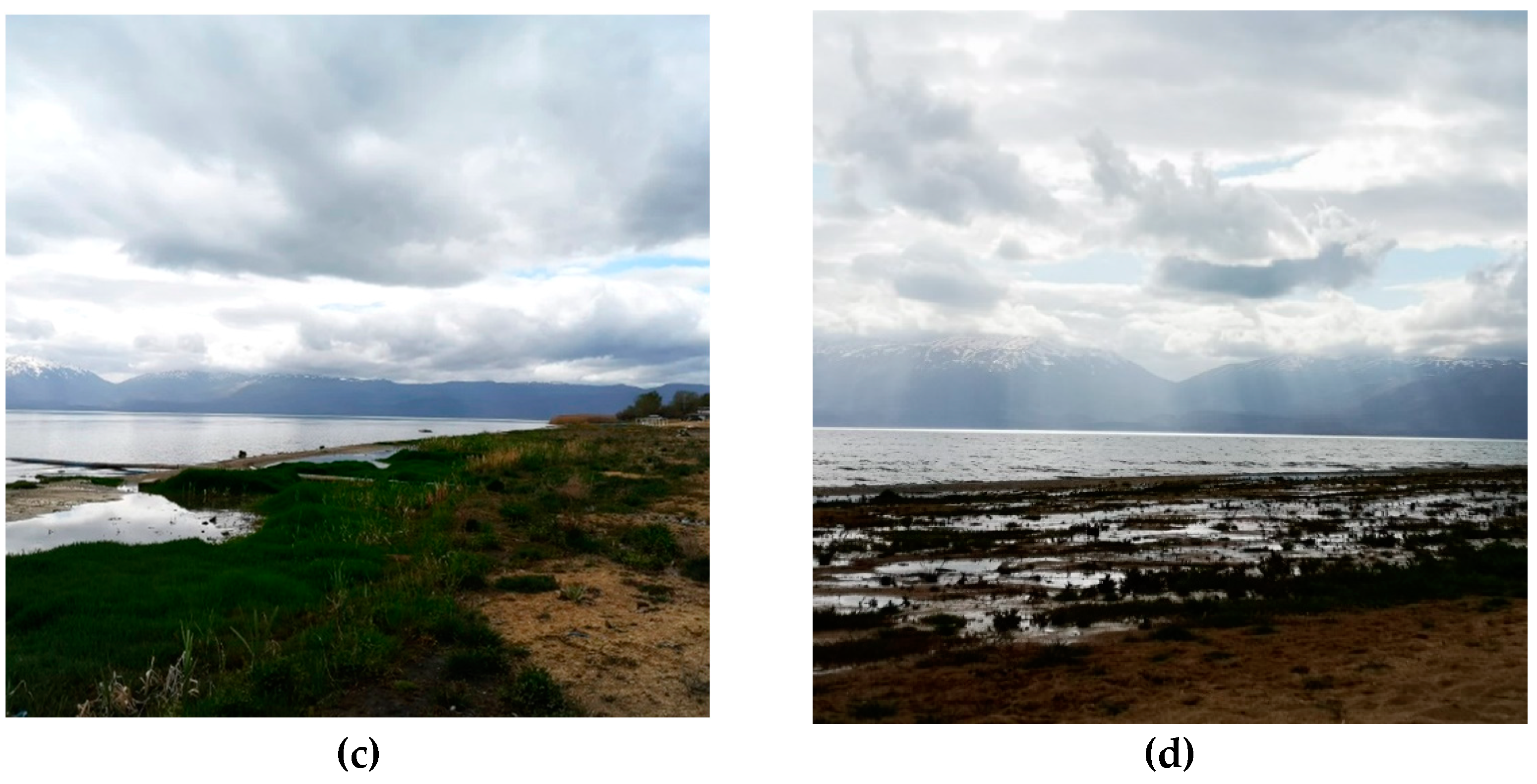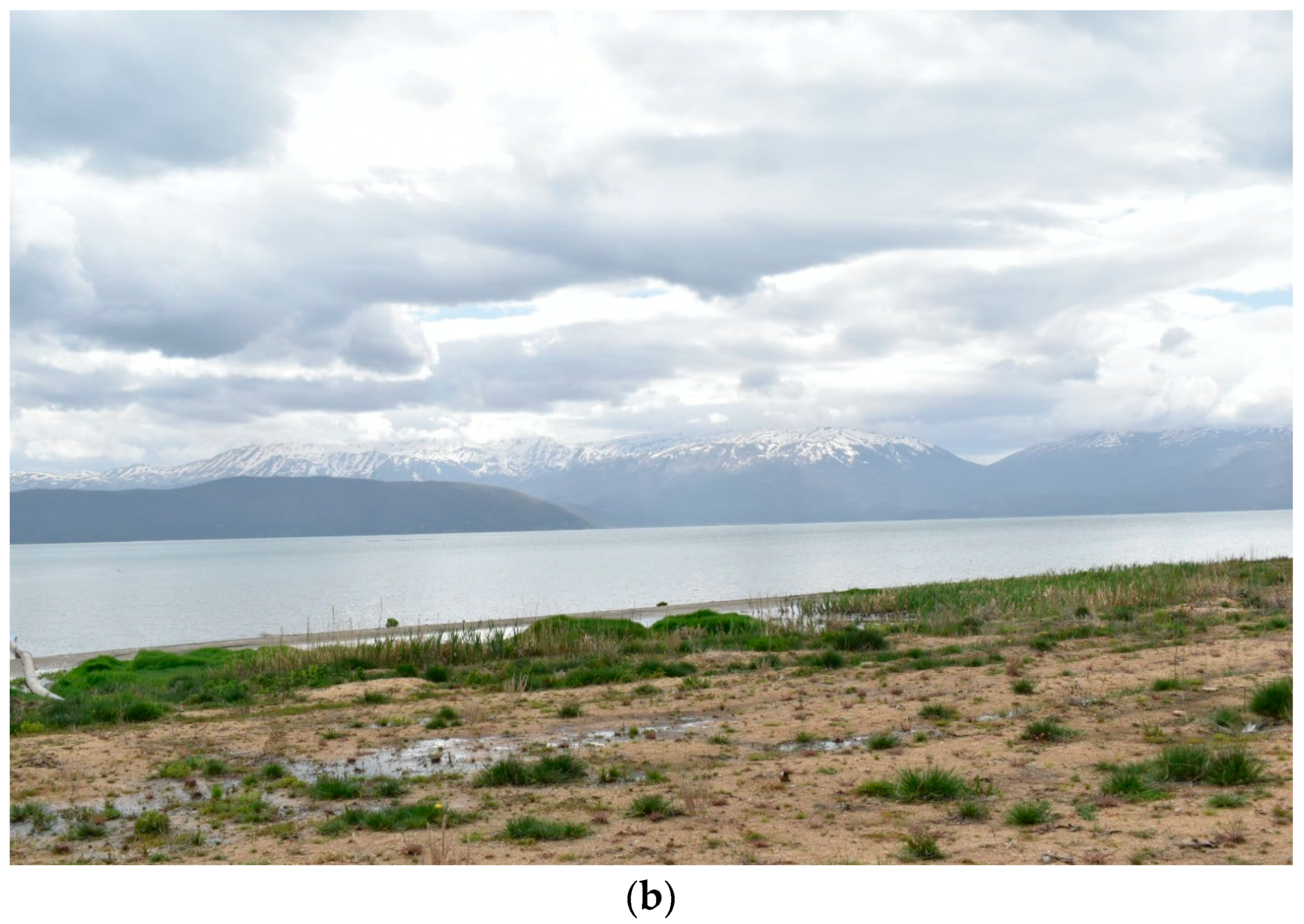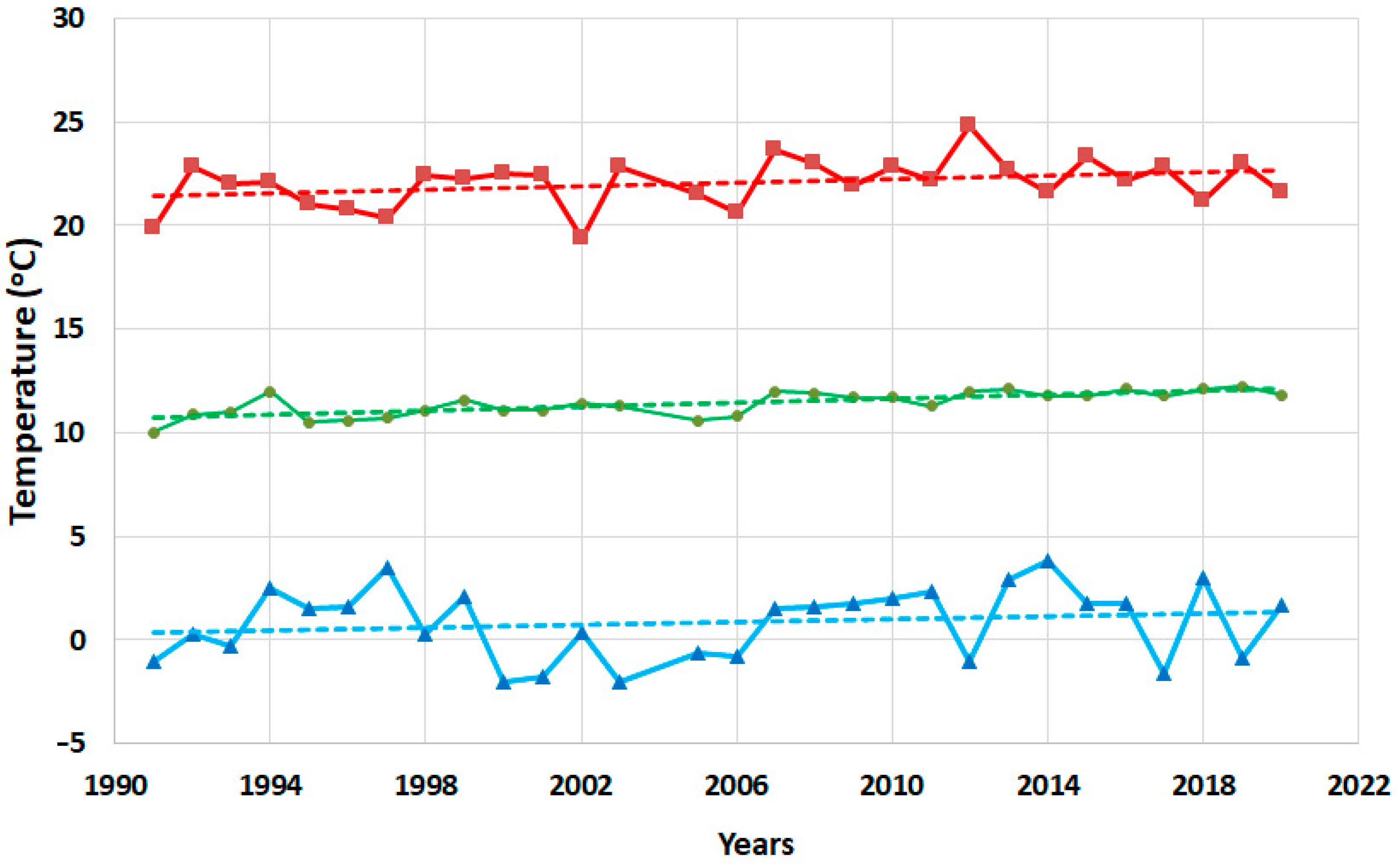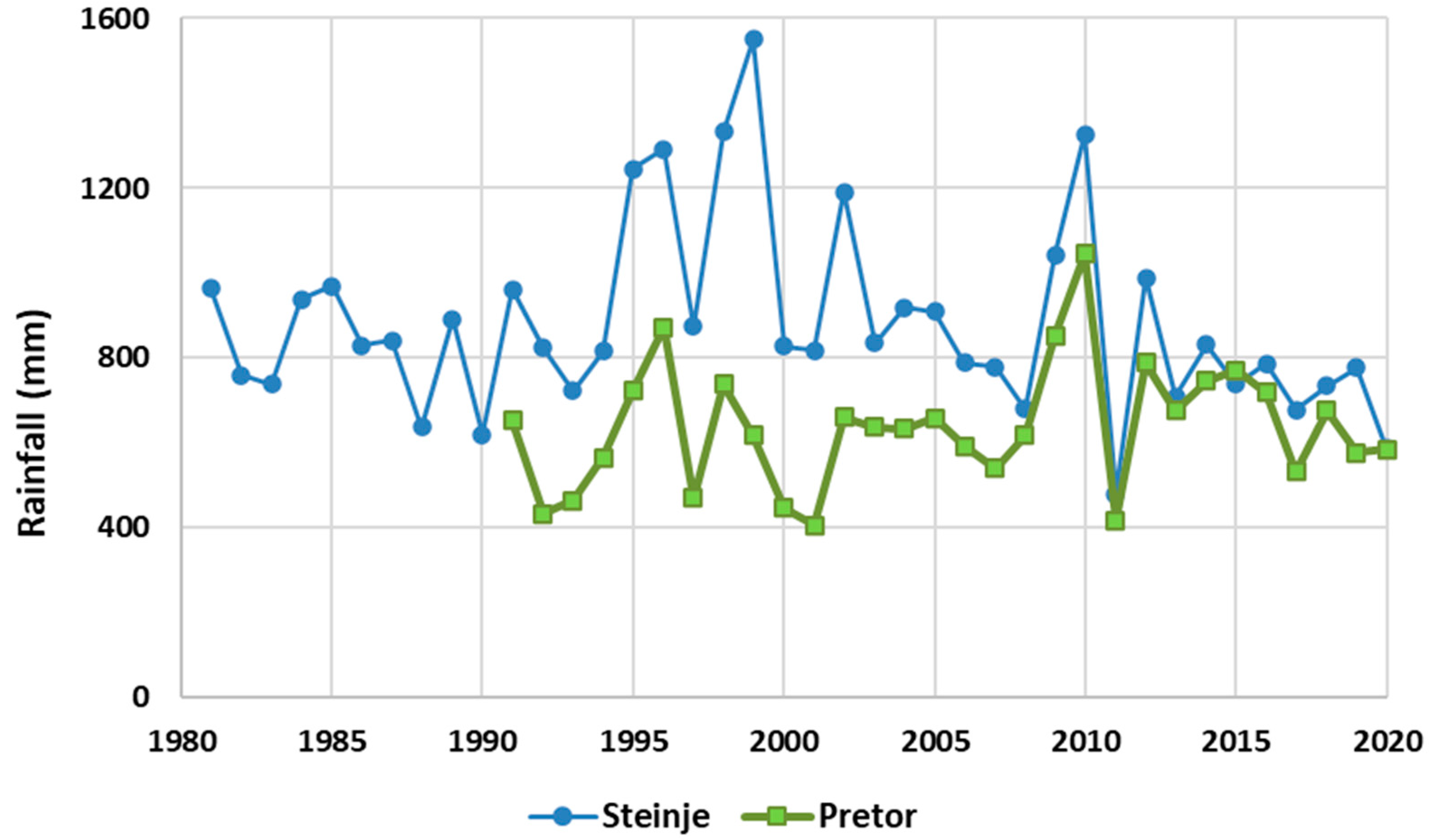Decrease in the Water Level of Lake Prespa (North Macedonia) Studied by Remote Sensing Methodology: Relation with Hydrology and Agriculture
Abstract
:1. Introduction
2. Materials and Methods
2.1. Study Site
2.2. Meteorological Data
2.3. Satellite Processing
3. Results
3.1. Climate
3.2. Hydrological Changes
3.3. Vegetation Intensity
4. Discussion
5. Conclusions
Author Contributions
Funding
Institutional Review Board Statement
Informed Consent Statement
Data Availability Statement
Acknowledgments
Conflicts of Interest
Appendix A


References
- Wetzel, R.G. Limnology, 3rd ed.; Elsevier: San Diego, CA, USA, 2001. [Google Scholar]
- Popovska, C.; Bonacci, C. Basic data on the hydrology of Lakes Ohrid and Prespa. Hydrol. Process. 2007, 21, 658–664. [Google Scholar] [CrossRef]
- Mitsch, W.J.; Gosselink, J.G. Wetlands; John Wiley & Sons: Hoboken, NJ, USA, 2015. [Google Scholar]
- Jeppesen, E.; Brucet, S.; Naselli-Flores, L.; Papastergiadou, E.; Stefanidis, K.; Noges, T.; Noges, P.; Attayde, J.L.; Zohary, T.; Coppens, J.; et al. Ecological impacts of global warming and water abstraction on lakes and reservoirs due to changes in water level and related changes in salinity. Hydrobiologia 2015, 750, 201–227. [Google Scholar] [CrossRef]
- Micklin, P. The past, present, and future Aral Sea. Lakes Reserv. Res. Manag. 2010, 15, 193–213. [Google Scholar] [CrossRef]
- Pham-Duc, B.; Sylvestre, F.; Papa, F.; Frappart, F.; Bouchez, C.; Crétaux, J.F. The Lake Chad hydrology under current climate change. Sci. Rep. 2020, 10, 5498. [Google Scholar] [CrossRef] [PubMed] [Green Version]
- UNESCO. Ohrid-Prespa Transboundary Biosphere Reserve, Albania/North Macedonia. Available online: https://en.unesco.org/biosphere/eu-na/ohrid-prespa (accessed on 15 May 2022).
- Ramsar Convention Secretariat. List of Transboundary Ramsar Sites. (Ramsar Convention Secretariat: Gland, Switzerland). Available online: https://www.ramsar.org/sites/default/files/documents/library/list_of_transboundary_sites.pdf (accessed on 15 May 2022).
- Catsadorakis, G.; Roumeliotou, V.; Koutseri, I.; Malakou, M. Multifaceted local action for the conservation of the transboundary Prespa lakes Ramsar sites in the Balkans. Mar. Fresh. Res. 2021, 21, 123. [Google Scholar] [CrossRef]
- Petrovska, B.; Gacovski, Z.; Petrovska, N.; Uzunova, K.; Fejzulah, F.; Tekovski, Z. Profitability farm production of milk from Holstein Friesian breed in the Bitola part of Pelagonia, R. Macedonia. Int. Sci. Line J. Sci. Technol. 2019, 9, 39–45. [Google Scholar]
- Kastridis, A.; Stathis, D. Evaluation of Hydrological and Hydraulic Models Applied in Typical Mediterranean Ungauged Watersheds Using Post-Flash-Flood Measurements. Hydrology 2020, 7, 12. [Google Scholar] [CrossRef] [Green Version]
- Maliaka, V.; Lürling, M.; Fritz, C.; Verstijnen, Y.J.M.; Faassen, E.J.; van Oosterhout, F.; Smolders, A.J.P. Interannual and Spatial Variability of Cyanotoxins in the Prespa Lake Area, Greece. Water 2021, 13, 357. [Google Scholar] [CrossRef]
- Stanković, S. Contribution à la connaissance des lacs d’Ochrida et de Prespa. SIL Proc. 1929, 4, 588–599. [Google Scholar] [CrossRef]
- Löffler, H.; Schiller, E.; Kusel, E.; Kraill, H. Lake Prespa, a European natural monument, endangered by irrigation and eutrophication? Hydrobiologia 1998, 384, 69–74. [Google Scholar] [CrossRef]
- Aufgebauer, A.; Panagiotopoulos, K.; Wagner, B.; Schaebitz, F.; Viehberg Finn, A.; Vogel, H.; Zanchetta, G.; Sulpizio, R.; Leng, M.J.; Damaschke, M. Climate and environmental change in the Balkans over the last 17 ka recorded in sediments from Lake Prespa (Albania/F.Y.R. of Macedonia/Greece). Quat. Int. 2012, 274, 122–135. [Google Scholar] [CrossRef]
- Dörnhöfer, K.; Oppelt, N. Remote sensing for lake research and monitoring–Recent advances. Ecol. Ind. 2016, 64, 105–122. [Google Scholar] [CrossRef]
- Binding, C.E.; Jerome, J.H.; Bukata, R.P.; Booty, W.G. Trends in water clarity of the lower Great Lakes from remotely sensed aquatic color. J. Great Lakes Res. 2007, 33, 828–841. [Google Scholar] [CrossRef] [Green Version]
- Lu, S.; Ouyang, N.; Wu, B.; Wei, Y.; Tesemma, Z. Lake water volume calculation with time series remote-sensing images. Int. J. Remote Sens. 2013, 34, 7962–7973. [Google Scholar] [CrossRef]
- Li, Y.; Gao, H.; Zhao, G.; Tseng, K.H. A high-resolution bathymetry dataset for global reservoirs using multi-source satellite imagery and altimetry. Remote Sens. Environ. 2020, 244, 111831. [Google Scholar] [CrossRef]
- Erena, M.; Domínguez, J.A.; Atenza, J.F.; García-Galiano, S.; Soria, J.; Pérez-Ruzafa, Á. Bathymetry Time Series Using High Spatial Resolution Satellite Images. Water 2020, 12, 531. [Google Scholar] [CrossRef] [Green Version]
- Bastawesy, M.A.; Khalaf, F.I.; Arafat, S.M. The use of remote sensing and GIS for the estimation of water loss from Tushka lakes, southwestern desert, Egypt. J. Afr. Earth Sci. 2008, 52, 73–80. [Google Scholar] [CrossRef]
- Popov, V.; Anovski, T.; Gospavic, R. Sustainable management of Lake Prespa. The Art of Resisting Extreme Natural Forces. Trans. Eng. Sci. 2007, 58, 71–79. [Google Scholar] [CrossRef] [Green Version]
- Burchfiel, B.C.; King, R.W.; Todosov, A.; Kotzev, V.; Durmurdzanov, N.; Serafimovski, T.; Nurce, B. GPS results for Macedonia and its importance for the tectonics of the Southern Balkan extensional regime. Tectonophysics 2006, 413, 239–248. [Google Scholar] [CrossRef]
- van der Schriek, T.; Giannakopoulos, C. Determining the causes for the dramatic recent fall of Lake Prespa (southwest Balkans). Hydrol. Sci. J. 2017, 62, 1131–1148. [Google Scholar] [CrossRef] [Green Version]
- Gilbert, R.O. Statistical Methods for Environmental Pollution Monitoring; Van Nostrand Reinhold: New York, NY, USA, 1987. [Google Scholar]
- Hirsch, R.M.; Slack, J.R.; Smith, R.A. Techniques of trend analysis for monthly water quality data. Water Resour. Res. 1982, 18, 107–121. [Google Scholar] [CrossRef] [Green Version]
- Karnieli, A.; Agam, N.; Pinker, R.T.; Anderson, M.; Imhoff, M.L.; Gutman, G.G.; Panov, N.; Goldberg, A. Use of NDVI and Land Surface Temperature for Drought Assessment: Merits and Limitations. J. Clim. 2010, 23, 618–633. [Google Scholar] [CrossRef]
- Wittich, K.P.; Hansing, O. Area-averaged vegetative cover fraction estimated from satellite data. Int. J. Biometeorol. 1995, 38, 209–215. [Google Scholar] [CrossRef]
- Krstic, S. Environmental changes in lakes catchments as a trigger for rapid eutrophication—A Prespa Lake case study. In Studies on Environmental and Applied Geomorphology; IntechOpen: Shanghai, China, 2012; pp. 63–118. [Google Scholar] [CrossRef] [Green Version]
- Micklin, P. The Aral Sea disaster. Annu. Rev. Earth Planet. Sci. 2007, 35, 47–72. [Google Scholar] [CrossRef] [Green Version]
- Magrin, G. The disappearance of Lake Chad: History of a myth. J. Political Ecol. 2017, 23, 204–222. [Google Scholar] [CrossRef] [Green Version]
- Tourian, M.J.; Elmi, O.; Chen, Q.; Devaraju, B.; Roohi, S.; Sneeuw, N. A spaceborne multisensor approach to monitor the desiccation of Lake Urmia in Iran. Remote Sens. Environ. 2015, 156, 349–360. [Google Scholar] [CrossRef]
- Hesami, A.; Amini, A. Changes in irrigated land and agricultural water use in the Lake Urmia basin. Lake Reserv. Manag. 2016, 32, 288–296. [Google Scholar] [CrossRef]
- Golabian, H. Urmia Lake: Hydro-Ecological Stabilization and Permanence Macro-Engineering Seawater in Unique Environments; Springer-Verlag: Berlin/Heidelberg, Germany, 2010; pp. 365–397. [Google Scholar]
- Barideh, R.; Nasimi, F. Investigating the changes in agricultural land use and actual evapotranspiration of the Urmia Lake basin based on FAO’s WaPOR database. Agric. Water Manag. 2022, 264, 107509. [Google Scholar] [CrossRef]
- Popovska, C. Hydrology of Lake Prespa. Vodoprivreda 2016, 48, 19–28. [Google Scholar]
- Sánchez-García, J.Y.; Ramírez-Gutiérrez, A.G.; Núñez-Ríos, J.E.; Cardoso-Castro, P.P.; Rojas, O.G. Systems Thinking Approach to Sustainable Performance in RAMSAR Sites. Sustainability 2019, 11, 6469. [Google Scholar] [CrossRef] [Green Version]
- López-Espinoza, E.; Ruiz-Angulo, A.; Zavala-Hidalgo, J.; Romero-Centeno, R.; Escamilla-Salazar, J. Impacts of the Desiccated Lake System on Precipitation in the Basin of Mexico City. Atmosphere 2019, 10, 628. [Google Scholar] [CrossRef] [Green Version]
- El Mahrad, B.; Abalansa, S.; Newton, A.; Icely, J.D.; Snoussi, M.; Kacimi, I. Social-Environmental Analysis for the Management of Coastal Lagoons in North Africa. Front. Environ. Sci. 2020, 8, 37. [Google Scholar] [CrossRef]
- Notaro, M.; Holman, K.; Zarrin, A.; Fluck, E.; Vavrus, S.; Bennington, V. Influence of the Laurentian Great Lakes on regional climate. J. Clim. 2013, 26, 789–804. [Google Scholar] [CrossRef] [Green Version]
- Kastridis, A.; Kamperidou, V. Influence of land use changes on alluviation of Volvi Lake wetland (North Greece). Soil Water Res. 2015, 10, 121–129. [Google Scholar] [CrossRef] [Green Version]
- Jovanovski, M. Hydrogeological Survey on Groundwater in Macedonia; Faculty of Civil Engineering, University of Ss. Cyril and Methodius: Skopje, Republic of North Macedonia, 2009. [Google Scholar]
- Matzinger, A.; Jordanoski, M.; Veljanoska-Sarafiloska, E.; Sturm, M.; Müller, B.; Wüest, A. Is Lake Prespa Jeopardizing the Ecosystem of Ancient Lake Ohrid? Hydrobiologia 2006, 553, 89–109. [Google Scholar] [CrossRef]
- Bootsma, H.A.; Hecky, R.E. Conservation of the African Great Lakes: A limnological perspective. Conserv. Biol. 1993, 7, 644–656. [Google Scholar] [CrossRef]






Publisher’s Note: MDPI stays neutral with regard to jurisdictional claims in published maps and institutional affiliations. |
© 2022 by the authors. Licensee MDPI, Basel, Switzerland. This article is an open access article distributed under the terms and conditions of the Creative Commons Attribution (CC BY) license (https://creativecommons.org/licenses/by/4.0/).
Share and Cite
Soria, J.; Apostolova, N. Decrease in the Water Level of Lake Prespa (North Macedonia) Studied by Remote Sensing Methodology: Relation with Hydrology and Agriculture. Hydrology 2022, 9, 99. https://doi.org/10.3390/hydrology9060099
Soria J, Apostolova N. Decrease in the Water Level of Lake Prespa (North Macedonia) Studied by Remote Sensing Methodology: Relation with Hydrology and Agriculture. Hydrology. 2022; 9(6):99. https://doi.org/10.3390/hydrology9060099
Chicago/Turabian StyleSoria, Juan, and Nadezda Apostolova. 2022. "Decrease in the Water Level of Lake Prespa (North Macedonia) Studied by Remote Sensing Methodology: Relation with Hydrology and Agriculture" Hydrology 9, no. 6: 99. https://doi.org/10.3390/hydrology9060099






